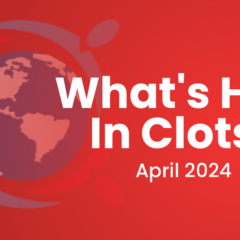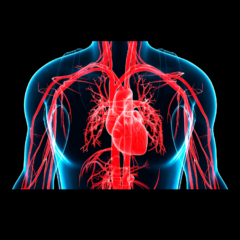Last updated on
Clot Chronicles: Marijuana Use and Cardiovascular Disease
Good morning. My name is Michael Givertz and I’m a cardiologist at the Brigham and Women’s Hospital in Boston. I’m the Medical Director of the Heart Transplant and Mechanical Circulatory Support Program and I’m a Professor of Medicine at Harvard Medical School, and I want to welcome you to Clot Chronicles. The topic of our conversation will be on marijuana use in patients with cardiovascular disease (CVD).
Now you might ask, “why does a heart transplant cardiologist have a particular interest in this area?” And as I think you’ll understand as we talk a little bit more, this topic comes up very frequently in patients—particularly younger patients—that we evaluate for advanced therapies, including mechanical support and heart transplant. It may impact one’s ability to adhere to their treatment after transplantation and to continue to do well following their transplant.
But for today’s discussion, I’m going to focus on a more general discussion of marijuana use in patients with CVD. This comes out of some work I recently did with my colleagues in a paper that we published earlier this year in the Journal of the American College of Cardiology, really a state-of-the-art review on this topic. The first author is a fellow colleague at Columbia, Dr. Ersilia DeFilippis, and the senior author is my colleague here at the Brigham, Dr. Muthiah Vaduganathan.So, I wanted to call your attention to that and I’m going to point out some of the important things we mentioned in our paper.
So, the first point I’d like to make—and I think most of you are well aware of—is the markedly increased use of marijuana and marijuana products in the United States and the health issue that this has really become. For those of you who are not familiar with it, recreational marijuana is now legal in 11 states, including the District of Columbia, and medical marijuana is legal now in 33 states for a variety of uses, including for patients with anorexia (for example, cancer patients), to treat chronic pain, and for treating anxiety as well as other specific conditions, such as seizure disorders or muscle spasms. Now, the laws vary, of course, from state to state, which leads to a lot of uncertainty in this area, both for clinicians as well as for patients.
Now, one of the things we know is that (if you watch the news), vaping has become incredibly common in the United States, particularly among younger adults and even within the teenage population. And there are many new products that are available, both legally and illegally. The other important point is that the potency of some of these new products, particularly some of the synthetic cannabinoids, can be nearly 100-fold more potent than what we would think of as typical marijuana. Another important point to make is that this is really a huge business. It’s estimated that by next year, the total sales of marijuana will reach over 25 billion dollars in the United States, so there are obviously huge interests in this area.
Now, I don’t want to spend a lot of time talking about the specifics of the different products, but it is important to mention that all of the CBD products can impact the CBD receptors—the cannabinoid receptors—and these are located really throughout the body, including, of course, the brain, in the endocrine system where they can impact appetite, as well as in the GI system, and particularly the cardiovascular system as we’re discussing this morning. So, there are cannabinoid receptors in myocytes, in vascular endothelial cells, as well as on smooth muscle cells.
Now, in our paper in the Journal of the American College of Cardiology, we point out that recent health surveys state that over 40 million Americans report either current use or use of marijuana products within the last year, and more than 80 million Americans report either current or any prior use of marijuana products. And we go on to estimate that probably more than 2 million persons in the United States with underlying cardiovascular disease have also reported either current or prior marijuana use. So, it really is a huge problem.
Now, one of the important points that we’ve made—and that I would like to highlight this morning—are the potential cardiovascular effects and mechanism of action of marijuana products. And again, we have a very nice figure in our paper that points to this, but there are really five of them.
- Concurrent hazards: Patients who use marijuana products but may also use other tobacco products, they may have alcohol use disorder, and they may use other drugs of abuse. So, first is concurrent hazards.
- Platelet activation: There is scientific evidence that marijuana can activate platelets and therefore potentially increase the risk of myocardial infarction (MI) and stroke.
- Effects on oxidative stress: In in vitro and animal models, it’s been shown that marijuana products can increase oxidative stress and therefore have a direct impact on, for example, peripheral arterial disease (PAD).
- The effect on the adrenergic nervous system: Marijuana products can increase heart rate and blood pressure and have been associated with risk of arrhythmia, particularly atrial fibrillation.
- The effect of marijuana or marijuana products on the myocardium, so direct myocardial effects. There are case reports of both stress cardiomyopathy as well as toxic myocarditis.
Now, one of our roles as CVD specialists is also to think about the medications that our patients take and how other medications or products can affect those drugs. And in fact, there are important drug-drug interactions that should be understood related to marijuana. Marijuana can inhibit a number of important enzymes, such as CYP34A as well as CYP2C9, and we know that these products can increase drug levels of some common cardiovascular medications, including antiarrhythmics, beta-blockers, calcium channel blockers, as well as warfarin and statins. So, it’s important to have these in the back of your mind, and if you don’t remember these interactions, work closely with your pharmacist to better understand the potential effect of marijuana on the drugs that your patients take.
So, just to bring this all to summary, what is our role as cardiovascular specialists in this area? Well, I would say first, and most importantly, is screening – particularly in younger patients who present unexpectedly. For example, with MI or stroke, it’s really important to screen for the use of marijuana or marijuana products, especially in areas of the country where there’s very high use. It’s important when we talk to our patients that we ask not only about the frequency of use, but the duration of use, and specifically which products are being used. As I mentioned, some of the newer synthetic products can be extremely potent relative to some of the older, more traditional marijuana products. It’s also important to take a history of other drug of abuse and take a history related to tobacco use as well – there can be some concomitant effects as I mentioned previously.
Secondly, counseling. Counseling is extremely important – that’s what we do as clinicians. So, explain to your patient what the potential risks of these products are and how these products may interact with the other products they take for their CVD. But I think it’s also important to recognize the limitations of the knowledge we have. There is some reasonable science out there, but there’s still so much we need to learn about marijuana and its effects on the cardiovascular system. And as I said, recognizing our own limitations in our knowledge; work closely with our colleagues in pharmacy to provide counseling both to us and our patients regarding how marijuana can affect drug levels of other important cardiovascular medications.
So, just to maybe end on a positive note, what would I see as the next steps in this area? Really, I would say there are three. The first is, of course, the need for guidelines. I spent several years working on and sharing guidelines for the Heart Failure Society of America and I think it’s extremely important that major cardiovascular societies get together and think about creating guidelines around this area of extreme importance to our patients with cardiovascular disease. Secondly, FDA regulation; the FDA needs to get involved with regulating the compounds that are on the market, both for recreational use as well as medical use. Lastly, and importantly, we are always trying to advance science and we need further research—and funding for research—to better understand what the interactions are that we discussed above and also how these can impact directly on our patients’ health, both in the short term and long term.
So again, I want to thank you for joining me on the Clot Chronicles. I look forward to talking to you again in the future on other related topics.



